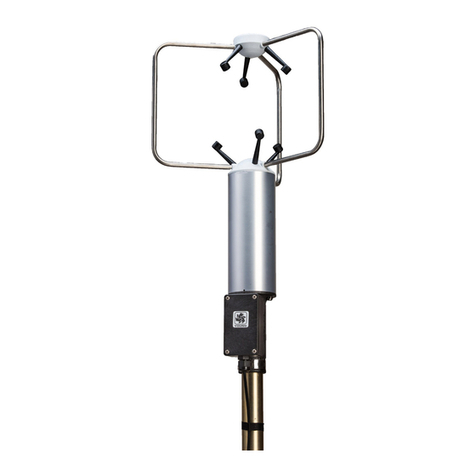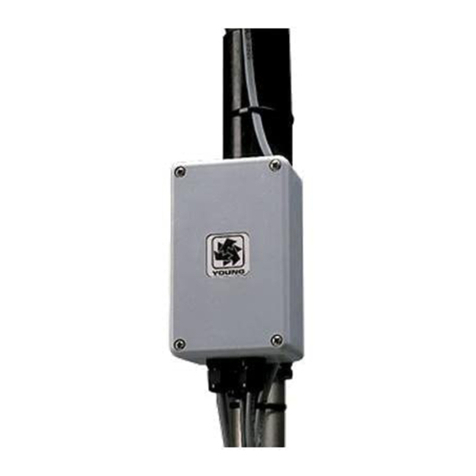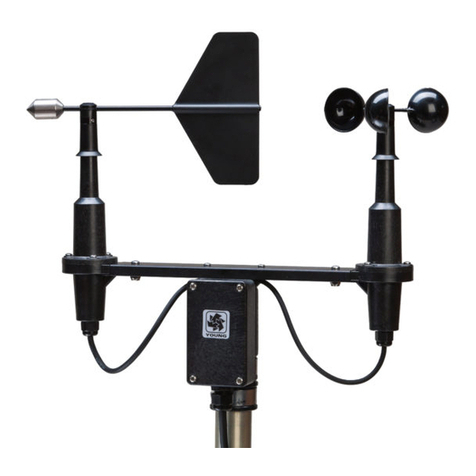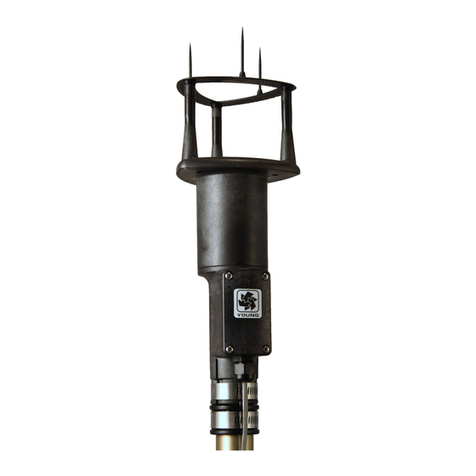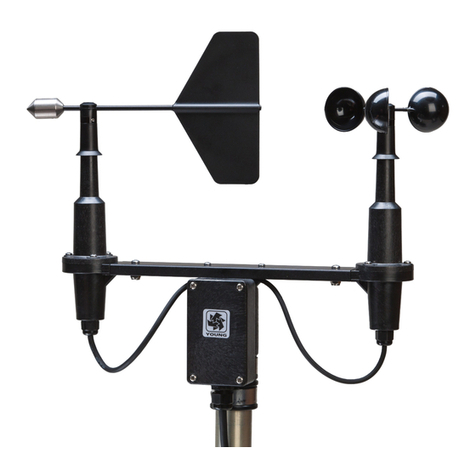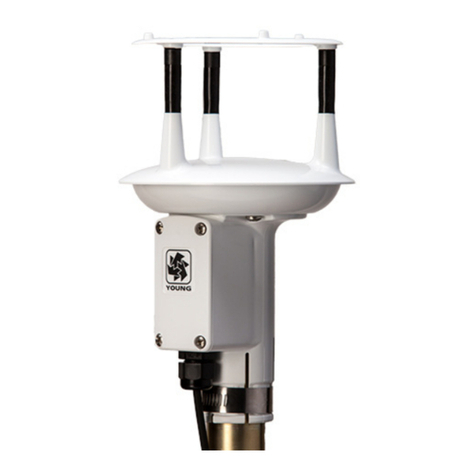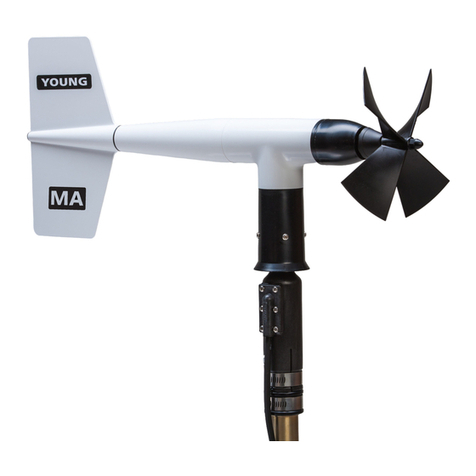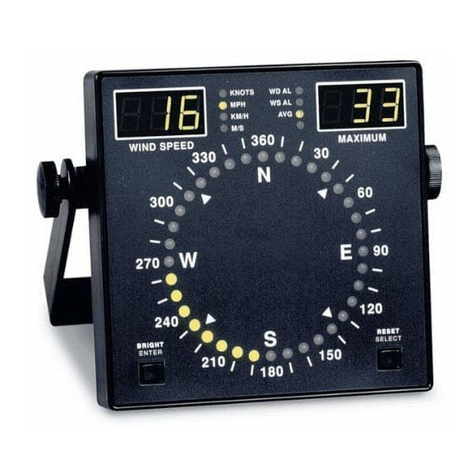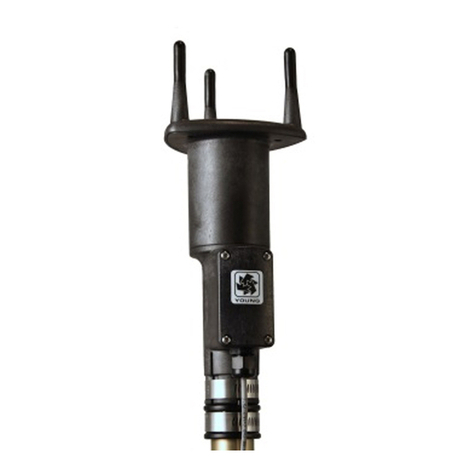
Page 2
03002L-90(D)
Vane alignment is most easily done with two people; one to adjust the
instrument position and the other to observe the indicating device.
When anemometer and vane are mounted on the same cross arm
(Model 03002), the azimuth potentiometer has been aligned at the
factory such that the mounting cross arm should be oriented North-
South with the vane on the North end.
To install the Wind Sentry, follow these steps:
1. MOUNT WIND SENTRY
a) Connect sensor cable to Wind Sentry junction box.
b) Place Wind Sentry on mounting post. Do Not tighten band
clamp yet.
c) Connect sensor cable to indicator.
2. ALIGN VANE
a) Select a known azimuth reference point on the horizon.
b) Sighting down vane center line, point counterweight at
reference point on horizon.
c) While holding vane in position, slowly turn base until indicator
displays proper value.
d) Tighten mounting post band clamp.
CALIBRATION
The Wind Sentry is fully calibrated before shipment and should
require no adjustments. Recalibration may be necessary after some
maintenance operations. Periodic calibration checks are desirable
and may be necessary where the instrument is used in programs
which require auditing of sensor performance.
For wind direction calibration, the following method can yield an
accuracy of ±5° or better if carefully done. Begin by connecting
the instrument to a signal conditioning circuit which indicates
wind direction value. This may be an indicator which displays
wind direction values in angular degrees or simply a voltmeter
monitoring the output. Hold or mount the instrument so the vane
center of rotation is over the center of a sheet of paper which has
30° or 45° cross markings. Position the instrument so the mounting
cross arm is oriented north-south with the vane on the north and the
anemometer on the south. With the counterweight pointing directly
at the anemometer the azimuth signal should correspond to 180°
or due south. Looking from above, visually align the vane with each
of the cross markings and observe the indicator display. It should
correspond to vane position within 5°. If not, it may be necessary
to adjust the relative position of the vane skirt and shaft. See step
3 in the MAINTENANCE section under potentiometer replacement.
It is important to note that while the sensor mechanically
rotates through 360°, full scale wind direction signal from the
signal conditioning occurs at 352°. The signal conditioning
electronics must be adjusted accordingly. For example, in a
circuit where 4 to 20 mA represents 0° to 360°, the output must
be adjusted for 19.6 mA when the instrument is at 352° full scale.
[((352°/360° X 16 mA) +4 mA)]
Wind speed calibration is determined by the cup wheel turning factor
and the output characteristics of the transducer. The calibration
formula relating cup wheel rpm to wind speed is shown below.
Standard accuracy is ±0.5 m/s (1.1 mph). For greater accuracy, the
sensor must be individually calibrated in comparison with a wind
speed standard. Contact the factory or your supplier to schedule a
NIST (National Institute of Standards & Technology) traceable wind
tunnel calibration in our facility.
To calibrate wind system electronics, temporarily remove the cup
wheel and connect a Model 18802 Anemometer Drive to the cup
wheel shaft. Apply the calibration formula to the motor rpm and adjust
the signal conditioning electronics for proper value. For example,
with the cup wheel shaft turning at 1800 rpm, adjust the indicator
to display 22.7 meters per second. (0.01250 X 1800 + 0.2 = 22.7)
CALIBRATION FORMULAS
Model 03102L Wind Sentry Anemometer
WIND SPEED vs CUP WHEEL RPM
m/s = (0.01250 x rpm) + 0.2
knots = (0.02427 x rpm) + 0.4
mph = (0.02795 x rpm) + 0.4
km/h = (0.04499 x rpm) + 0.7
WIND SPEED vs mA OUTPUT
m/s = (3.125 x mA) - 12.5
knots = (6.075 x mA) - 24.3
mph = (6.990 x mA) - 28.0
km/h = (11.250 x mA) - 45.0
WIND DIRECTION vs mA OUTPUT
DEGREES = (22.5 x mA)-90
MAINTENANCE
Given proper care, the Wind Sentry should provide years of
service. Because of its durable, corrosion resistant construction,
the instrument requires little maintenance. The only components
likely to require replacement due to normal wear are the precision
ball bearings and the azimuth potentiometer. Replacement of these
components should only be performed by a qualied instrument
technician. If service facilities are not available, return the instrument
to the factory. Refer to the accompanying drawings to become
familiar with part names and locations. Maximum torque on all set
screws is 80 oz-in.
POTENTIOMETER REPLACEMENT
The potentiometer has a life expectancy of fty million revolutions.
As it becomes worn, the element may produce noisy signals or
become non-linear. When the signal noise or non-linearity become
unacceptable, replace the potentiometer as follows:
1. REMOVE POTENTIOMETER
a) Remove three screws which secure upper and lower
sections of main housing.
b) Carefully remove upper housing exposing wiring
connections to circuit board.
c) Unsolder potentiometer wires from circuit board.
Note color coding.
d) Using a knife blade or similar instrument, loosen
potentiometer assembly from upper housing and slide
it out.
2. INSTALL NEW POTENTIOMETER
a) Slide new potentiometer cell into upper housing. Be
sure to engage cell key into housing notch.
b) Solder potentiometer wires to circuit board.
Observe color code.
c) Join two sections of main housing. Secure with screws
removed in step 1a.
3. ALIGN VANE
a) Connect excitation voltage and signal conditioning
electronics to instrument according to wiring diagram.
b) Loosen set screw in side of vane hub.
c) Position instrument so cross arm is oriented north-south
with vane on north side. Orient vane to a known angular
reference. (See CALIBRATION section.)
d) While holding vane in reference position, slowly turn
vane skirt until signal conditioning system indicates
proper value.
e) Ti g h t en se t s c r ew o n s i d e of v a n e h u b.
Do not exceed 80 oz-in torque.


